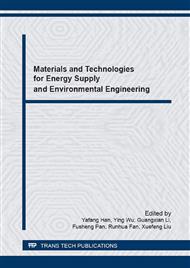p.8
p.14
p.22
p.26
p.29
p.33
p.39
p.46
p.50
Lithium Storage Property of Metallic Silicon Treated by Mechanical Alloying
Abstract:
Theoretical capacity of silicon is 4200mAhg-1, but pure silicon had huge volume change during lithium insertion, which reduces the cycle life of silicon. In this paper, pure silicon was replaced of metallic silicon to relieve volume effect. Metallic silicon contains some alloying elements which improve the conductivity of the electrode material. The elements in metallic silicon will relief the volume change of silicon substrate during lithium insertion/ de-lithiation process. Metallic silicon was treated by mechanical alloying (MA) which is an effective method to reduce particle sizes of metallic silicon. The results show that MA can improve cycle performance of metallic silicon. Metallic silicon treated by MA performs a better cycling performance compared with the unsettled materials and a higher discharge capacity in the first cycle.
Info:
Periodical:
Pages:
29-32
Citation:
Online since:
March 2016
Authors:
Price:
Сopyright:
© 2016 Trans Tech Publications Ltd. All Rights Reserved
Share:
Citation:


